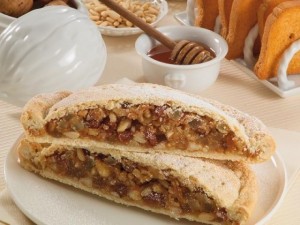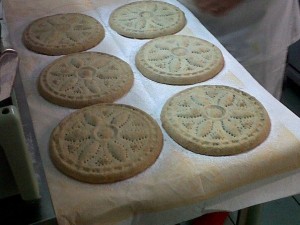Spongata
Spongata is a flat round cake made with a thin, crunchy pastry dough, covered with powdered sugar. It has a soft, light-brown filling with a very pronounced, spiced flavor.
HISTORY
The original recipe was first written down at the end of the 14th century. The cake is made of toasted bread, walnuts, honey, sugar, pine nuts, raisins, cloves, nutmeg, cinnamon, orange peel and white wine. Its name comes from the Italian word for spunge, or spugna, referring to the consistency of the filling, the small holes on the outside.
Some people believe that spongata was brought to Italy by the Jews, while others suggest that it is a Roman dish that was kept alive during the Middle Ages thanks to the tradition of panes melati ac pepati, or spiced, honey breads. The ducal family of Este regulated the production of spongata by a special decree.
Spongata is made in and around Reggio Emilia and Brescello. It is also produced in the provinces that border Parma, including Busseto, Corniglio, Berceto, Cassio, Piacenza and Modena. Traditionally, it can also be found in Pontremoli, in the Valle del Magra , and in Sarzana. In Busseto, spongata has particular historical importance. While Giuseppe Verdi was composing Don Carlos, he would visit the Antica Pasticceria Muggia, founded in 1867.
The pastry shop served a special dessert made of pastry dough, filled with honey, almonds, pine nuts, candied fruit, citron and raisins. Verdi thought the cake was a masterpiece and the spognata became the official dessert of Busseto. In Brescello, a small city near Reggio Emilia, spongata was first documented in 1454 and the following year a cake was sent to the duke of Borso d’Este. Thanks to priest don Palazzi, the ancient recipe for the real Spongata di Brescello was rediscovered in 1830 and given to Panizzi, a spice vendor. Since 1863, Spongata di Brescello has been associated with Luigi Benelli, who commercialized production of this regional specialty.
In the past, spongata was made during the winter, beginning on All Saint’s Day, or November 2nd. The cake was stored in special containers. Today, it is available year round and you can even find a chocolate version.
4 spongate of about cm. 22 in diameter
For the stuffing:
g. 400 acacia honey
g. 100 White wine
g. 100 raisins
g. 200 of rusks chopped
g. 100 Almond
g. 100 Walnut
g. 100 hazelnut
g. 100 of candied citron
g. 100 candied orange
g. 60 pine nuts
g. 5 ground cinnamon
nutmeg, clove powder, salt, pepper
For the dough:
g. 600 flour
g. 40 of sugar
g. 200 of butter
g. 200 White wine
Method:
for the stuffing:
Soak the raisins in warm water. Put in a pot the wine and honey and let it melt. Blend the dried fruit with the rusks. Combine honey dissolved in wine, chopped nuts, candied fruit, raisins squeezed, cinnamon, a pinch of nutmeg, one of cloves and one of pepper. Return the saucepan on the stove and stir until the mixture will be uniform. Remove from heat, let cool, cover and let stand overnight.
For the dough:
Mix the flour with the butter, sugar, a pinch of salt and wine. Mix to obtain a firm dough that will go to rest, wrapped in plastic wrap, for an hour in the refrigerator.
For spongate:
Divide the dough into eight portions and the filling into 4 parts.
Start to stretch a portion of dough at a time, leaving in the meantime the other wrapped in the film to prevent it drying out.
Proceed preparing a spongata at time: apply two portions of dough into thin disks of cm. 22 in diameter.
Crush the portion of filling between two sheets of parchment paper in a disk cm. 20 in diameter.
Line a plate of the oven with baking paper and place a first disk of dough, cover with a disc of stuffing and cover with a second disk of dough by matching the edges of the two discs and seal pinching and rolling them in order to form a cord.
Decorate the surface practicing regular small cuts with scissors.
Do the same the other 3 spongate.
Bake at 190 ° C convection oven for 30 minutes, will have to be lightly browned.
Allow to cool, sprinkle with powdered sugar and wrap each spongata in aluminum foil.
Closed in a hermetically sealed housing or well wrapped it will keep up to a month.






Leave a comment